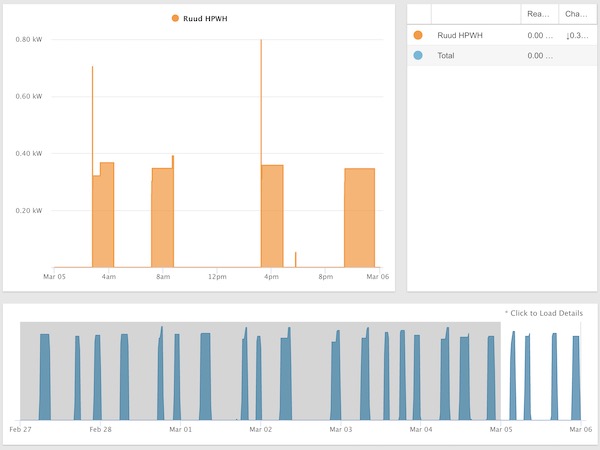How quickly will we electrify our homes? This is an important question as we set emissions goals and formulate plans to achieve them. A few years ago, Palo Alto determined that the most cost-effective approach to hitting our 80x30 goal would entail (among other things) replacing nearly every gas appliance in our single-family homes with electric heat pumps. (The “80x30” goal aims to reduce emissions 80% below 1990 levels by 2030.)
Some of you may be thinking that’s a non-starter. Some of you may be curious about the possibility. Others of you may already have done it and see little downside. What the city wants to know is, in general, how long can we expect this to take if the city provides a good assist?
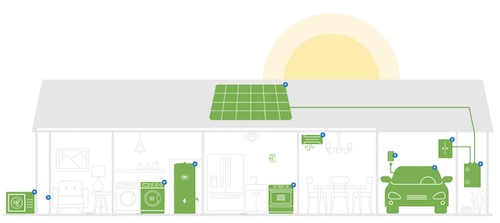
A gas-free home, as depicted in Peninsula Clean Energy’s excellent Design Guidelines for Home Electrification
There are many factors that affect the answer to that question. Where are gas heaters installed, how hard are they to swap out for efficient electric versions, how much will that cost, what concerns do homeowners have, and so on. How do you go about determining how long it will take?
Well, it helps to look at a lot of homes and to start by focusing on one type of appliance. The city’s compelling heat pump water heater program is designed to provide some answers. Palo Alto is offering homeowners not only a significant financial subsidy to replace a gas water heater with an efficient electric one, but also a turnkey service that enables residents to make the switch with little more than an email or phone call to the city.
Says Jonathan Abendschein, Assistant Director for Utilities Resource Management: “Our program is meant to make it really easy for people to replace their gas water heater with a heat pump water heater. It is designed to be a white glove service. We have our own contractor. You call us, we’ll get your site assessed, we’ll take care of the permits, our contractor will do the installation. You don’t really have to think about it.”
In practice, the homeowner fills out a brief online form and then sets a time for an assessor to come by. The assessor will determine what’s needed for the installation and will also go over options for electrifying space heating if there is interest. Within a week or two, the homeowner receives an estimate and can schedule the installation.
Abendschein adds: “We’ve been able to offer a really attractive price for the first pilot phase of this program. The total cost is $2700 but we also have on-bill financing where you pay just $1500 up front and then $20 per month on your utility bill for five years.”
Since in many cases it costs about $1500 to install a gas water heater, and households can save $5-$20/month on their energy bill with an efficient heat pump water heater, the cost can be similar to that of installing a gas water heater. (1)
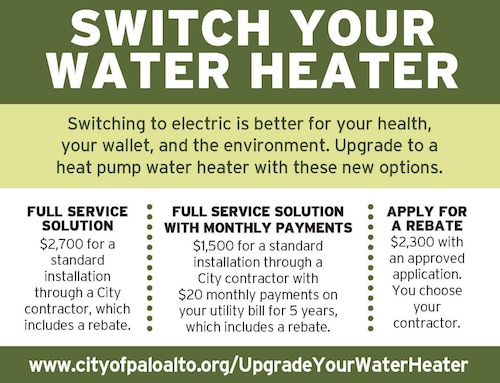
Palo Alto has made a substantial investment of time and money in this program, and has forged a close relationship with a committed partner in Synergy. Together they are pursuing a goal of replacing 1000 gas water heaters with heat pump water heaters in one year. That is a rate of 20 per week for 50 weeks. How is it going?
So far 500 households have expressed interest and over 200 assessments have been completed or scheduled. The contractor and the city have addressed some staffing issues that led to response and scheduling delays in the first few months, and are now ramping up the process. It should take only about one week from when a homeowner reaches out to the city to when an assessment can be scheduled.
The assessment in and of itself is a valuable free service. I’d love to see everyone sign up for it, or at least everyone with an older gas water heater. It helps a homeowner to understand the electrification potential of their residence and to qualify for the excellent pricing and service this pilot provides before it ends.

In turn, the city gets a clearer sense of what these replacements look like in practice and what technical or other obstacles exist to a straightforward swap in some homes. City staff can better understand the labor and equipment costs for the installer as well as learn about the age and efficiency of gas appliances in homes. This is useful information as we evaluate our emission reduction plans and consider future potential pilots (e.g., for electrifying space heating/cooling).
What does the program look like in practice? I spoke with a Palo Alto resident who was one of the first in line. She had seen her neighbor’s water heater start leaking and their subsequent rush to replace it. Her water heater was fifteen years old and she was eager to get a streamlined climate-friendly replacement. “The whole process was very easy,” she said. The contractor and a city representative came out at the scheduled day and time for the assessment, which took 30-60 minutes, then once she accepted the estimate, the permitting was taken care of and the installation happened on time, complete within a day.
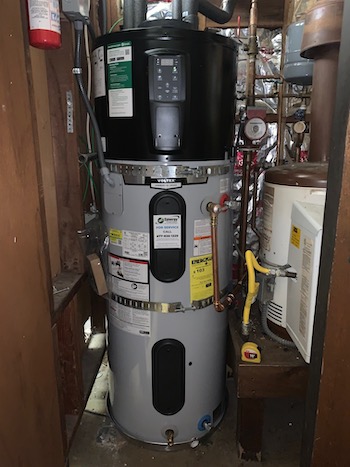
The new HPWH is in a closet in the garage, next to an older radiant boiler.
The resident is happy with the quality of the work. “The electrician found a really nice way to connect the conduit on the roof to the water heater, so it doesn’t go through the roof and is barely visible. The plumber was also very helpful when I wanted to use the old heater’s water in my garden. Both workmen were very nice and did good work.”
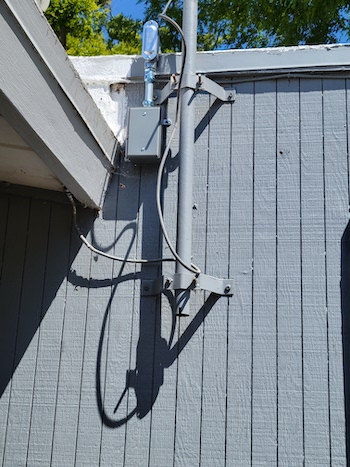
The conduit on the roof is nicely connected to the water heater in the garage.
The resident observed that Synergy’s scheduling service could have been better. They seemed confused about a few things (e.g., when scheduling a follow-up visit and then the inspection), but Abendschein says after some early learning, the team is better prepared now to handle requests. The resident also felt bad that the electrician had come all the way from Sacramento, and hopes that more local people are available going forward.
The heater itself is working well. The homeowner chose a 50-gallon heat pump water heater to replace the old 50-gallon gas water heater. That works out well for her family and saved a little bit of money. It heats their water nicely, even when set at 130 degrees. (2) She likes the easy Vacation mode on the water heater, and the ability to set it in Hybrid mode if there are many people at the house. (That mode will use both heat pump and electric resistance heat as needed.) She said she can hear a hum from the appliance when she is in the garage and it’s running, but it doesn’t seem to run often. In the kitchen, if it’s quiet, she will sometimes hear it as if the refrigerator is running. She has not noticed her garage being any cooler.
One surprise for her was that there is more condensation than she expected. It drains onto their patio, and for now she has put a small cup there to catch it, which she occasionally empties into the yard.

Homeowners use a small cup to capture condensate from the water heater
One thing that I heard from this homeowner, which I have heard from others and which was my experience as well, is that it makes sense to think through all of your electrical needs when running conduit. When I installed an EV charger, I didn’t think ahead to other electrical needs I would have, and ended up needing to redo the conduit (make it larger) and put in a subpanel. Similarly, the conduit that this home had in place for an EV charger would not handle the additional load of the HPWH, so they had to put in a second line. That was an extra $2000 charge, since it runs all the way across the roof of the house. To prevent that from happening again, the contractor offered to put in larger-than-needed conduit and space for a future connection so they can easily electrify their boiler when the time comes.
In general, the resident is happy with the new water heater, grateful that the city’s program made the conversion very simple, and encouraged to have made a dent in her home’s use of gas and prepared to make more.
The gas that we burn in our homes and our cars contributes to the warming that our planet has been experiencing over the past decades. It is only going to get more expensive relative to electricity over the coming years because of the damage it is causing. It is great that our city is stepping up to help us reduce our gas use. This program, focused on water heaters in single-family homes, is something that I hope many of you will take advantage of. You can sign up here.
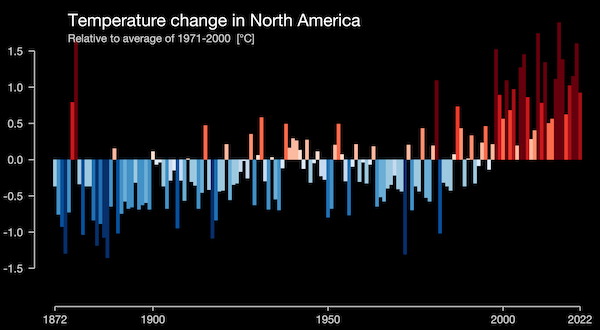
Temperatures in North America have warmed quickly over the past few decades. Source: #ShowYourStripes
Notes and References
1. Some installations will incur extra costs, such as if a panel upgrade is needed or a very long conduit is needed to connect the water heater to a distant panel. These electric upgrades can be done in such a way that they make it much easier to later install an EV charger, an electric heat pump, and/or other electric appliances.
2. Initially the residents had the temperature set to 140, but on a return visit the contractor said that was probably too hot and so they settled on 130.
Current Climate Data (April 2023)
Global impacts, US impacts, CO2 metric, Climate dashboard
Comment Guidelines
I hope that your contributions will be an important part of this blog. To keep the discussion productive, please adhere to these guidelines or your comment may be edited or removed.
- Avoid disrespectful, disparaging, snide, angry, or ad hominem comments.
- Stay fact-based and refer to reputable sources.
- Stay on topic.
- In general, maintain this as a welcoming space for all readers.




